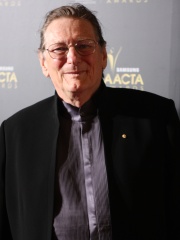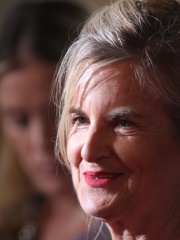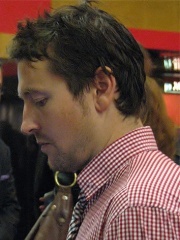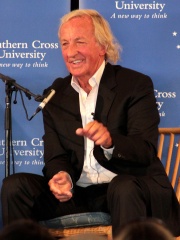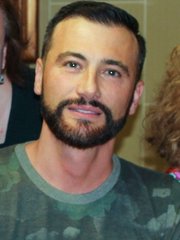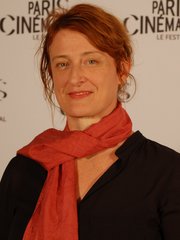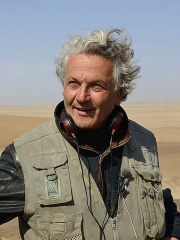
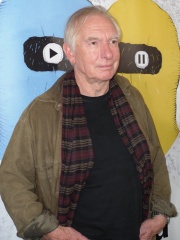
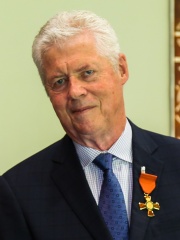
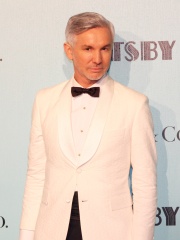
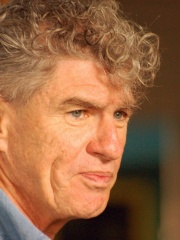
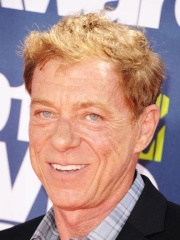
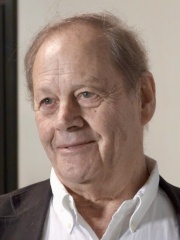
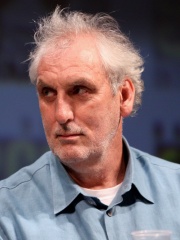
The Most Famous
FILM DIRECTORS from Australia
This page contains a list of the greatest Australian Film Directors. The pantheon dataset contains 2,041 Film Directors, 28 of which were born in Australia. This makes Australia the birth place of the 16th most number of Film Directors behind Czechia, and China.
Top 10
The following people are considered by Pantheon to be the top 10 most legendary Australian Film Directors of all time. This list of famous Australian Film Directors is sorted by HPI (Historical Popularity Index), a metric that aggregates information on a biography's online popularity. Visit the rankings page to view the entire list of Australian Film Directors.

1. George Miller (b. 1945)
With an HPI of 74.10, George Miller is the most famous Australian Film Director. His biography has been translated into 44 different languages on wikipedia.
George Miller (born 3 March 1945) is an Australian filmmaker. Over the course of four decades he has received critical and popular success, and is widely known for creating and directing every film in the Mad Max franchise starting in 1979, including two entries which are considered two of the greatest action films of all time according to Metacritic. He has earned numerous accolades including an Academy Award from six nominations in five different categories. His directing career started in Australia with the first three Mad Max films between 1979 and 1985 with his friend and producing partner Byron Kennedy, after which he transitioned to Hollywood with The Witches of Eastwick (1987). His family drama Lorenzo's Oil (1992) earned him his first Academy Award nomination after which he produced and co-wrote Babe (1995) and directed the sequel Babe: Pig in the City (1998). He would venture into animation with Happy Feet (2006), for which he won the Academy Award for Best Animated Feature, and the sequel Happy Feet Two (2011), before returning to Mad Max with the acclaimed Mad Max: Fury Road (2015), which went on to win six Academy Awards, and Furiosa: A Mad Max Saga (2024). Trained in medicine at the University of New South Wales, Miller worked as a physician for several years before entering the film industry. Miller and Kennedy are the founders of the production house Kennedy Miller Mitchell. Since the death of Kennedy in 1983, his main producers have been his younger brother Bill Miller and Doug Mitchell. Other accolades include a British Academy Film Award, a Critics Choice Awards, a Golden Globe Award and six Australian Academy of Cinema and Television Arts Awards.

2. Peter Weir (b. 1944)
With an HPI of 68.44, Peter Weir is the 2nd most famous Australian Film Director. His biography has been translated into 46 different languages.
Peter Lindsay Weir ( WEER; born 21 August 1944) is an Australian retired film director, screenwriter, and producer. He directed films crossing various genres over forty years with films such as Picnic at Hanging Rock (1975), Gallipoli (1981), The Year of Living Dangerously (1982), Witness (1985), Dead Poets Society (1989), Fearless (1993), The Truman Show (1998), Master and Commander: The Far Side of the World (2003), and The Way Back (2010). He has received six Academy Award nominations and he has won two AACTA Award for Best Direction and two BAFTA Award for Best Direction. In 2022, he was awarded the Academy Honorary Award for his lifetime career achievement. In 2024, he received an honorary life-time achievement award at the Venice Film Festival (Golden Lion). Early in his career as a director, Weir was a leading figure in the Australian New Wave cinema movement (1970–1990). Weir made his feature film debut with Homesdale (1971), and continued with the mystery drama Picnic at Hanging Rock (1975), the supernatural thriller The Last Wave (1977) and the historical drama Gallipoli (1981). Weir gained tremendous success with the multinational production The Year of Living Dangerously (1982). After the success of The Year of Living Dangerously, Weir directed a diverse group of American and international films covering most genres—many of them major box office hits—including Academy Award–nominated films such as the thriller Witness (1985), the drama Dead Poets Society (1989), the romantic comedy Green Card (1990), the social science fiction comedy-drama The Truman Show (1998) and the epic historical drama Master and Commander: The Far Side of the World (2003). His final feature before his retirement was The Way Back (2010).

3. Roger Donaldson (b. 1945)
With an HPI of 59.61, Roger Donaldson is the 3rd most famous Australian Film Director. His biography has been translated into 24 different languages.
Roger Lindsey Donaldson (born 15 November 1945) is an Australian and New Zealand film director, screenwriter, and producer. His 1977 debut film, Sleeping Dogs, is considered a landmark work of New Zealand cinema, as one of the country’s first films to attract large-scale critical and commercial success. He has subsequently directed 17 feature films, working in Hollywood and the United Kingdom, as well as his native country. Donaldson’s best-known films include the historical drama The Bounty (1984), the neo-noir No Way Out (1987), the romantic comedy Cocktail (1988), the Cuban Missile Crisis docudrama Thirteen Days (2000), the science-fiction horror film Species (1995), the disaster film Dante's Peak (1997), the Burt Munro biopic The World's Fastest Indian (2005), and the historical thriller The Bank Job (2008). Donaldson has worked twice each with actors Kevin Costner, Pierce Brosnan, Anthony Hopkins and Michael Madsen. He is a recipient of three New Zealand Film and Television Awards. He is also an AACTA Award and Palme d’Or nominee. At the 2018 Queen's Birthday Honours, Donaldson was appointed an Officer of the New Zealand Order of Merit, for services to film.

4. Baz Luhrmann (b. 1962)
With an HPI of 59.52, Baz Luhrmann is the 4th most famous Australian Film Director. His biography has been translated into 43 different languages.
Bazmark Anthony "Baz" Luhrmann (born 17 September 1962) is an Australian film director, producer, writer and actor whose various projects extend from film and television into opera, theatre, music and the recording industries. He is regarded by some as a contemporary example of an auteur for his style and deep involvement in the writing, directing, design and musical components of all his work. He is the most commercially successful Australian director, and four of his films are in the top ten highest worldwide grossing Australian films ever. On the screen, he is best known for his Red Curtain Trilogy, comprising the romantic comedy film Strictly Ballroom (1992) and the romantic tragedies William Shakespeare's Romeo + Juliet (1996) and Moulin Rouge! (2001). Following the trilogy, projects included Australia (2008), The Great Gatsby (2013), Elvis (2022) and the television period drama The Get Down (2016) for Netflix. Additional projects include stage productions of Giacomo Puccini's La bohème for both Opera Australia and Broadway, and Strictly Ballroom the Musical (2014). In September 2025 he is expected to release his first documentary, EPiC: Elvis Presley in Concert. Luhrmann is known for his Grammy Award-nominated soundtracks for Moulin Rouge! and for The Great Gatsby, as well as his record label House of Iona, a co-venture with RCA Records. Serving as producer on all his musical soundtracks, he also holds writing credits on many of the individual tracks. His album Something for Everybody features music from many of his films and also includes his hit "Everybody's Free (To Wear Sunscreen)".
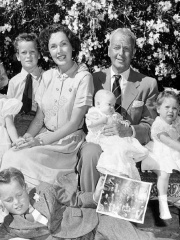
5. John Farrow (1904 - 1963)
With an HPI of 59.44, John Farrow is the 5th most famous Australian Film Director. His biography has been translated into 31 different languages.
John Villiers Farrow, KGCHS (10 February 1904 – 27 January 1963) was an Australian film director, producer, and screenwriter. Spending a considerable amount of his career in the United States, he was nominated for the Academy Award for Best Director in 1942 for Wake Island, and in 1957, he won the Academy Award for Best Adapted Screenplay for Around the World in Eighty Days. He had seven children by his wife, actress Maureen O'Sullivan, including actress Mia Farrow.

6. Christopher Doyle (b. 1952)
With an HPI of 59.18, Christopher Doyle is the 6th most famous Australian Film Director. His biography has been translated into 27 different languages.
Christopher Doyle (born 2 May 1952), also known as Dou Ho-fung (traditional Chinese: 杜可風; simplified Chinese: 杜可风; pinyin: Dù Kěfēng), is an Australian cinematographer, best known for his work in Hong Kong cinema. He has worked on over fifty Chinese-language films, being best known for his collaborations with Wong Kar-wai in Fallen Angels, Chungking Express, Happy Together, In the Mood for Love and 2046. Doyle is also known for other films such as Temptress Moon, Hero, Dumplings, and Psycho. He has won awards at the Cannes Film Festival and Venice Film Festival, as well as the AFI Award for cinematography, the Golden Horse award (four times), and the Hong Kong Film Award (six times).

7. Russell Mulcahy (b. 1953)
With an HPI of 58.82, Russell Mulcahy is the 7th most famous Australian Film Director. His biography has been translated into 27 different languages.
Russell Mulcahy ( mul-KA-hee; born 23 June 1953) is an Australian director, writer, and producer. He began his career directing music videos for artists like Elton John and Duran Duran, before making his feature directorial debut with the horror film Razorback (1984). He achieved international prominence by directing the fantasy action film Highlander (1986), which spawned a multimedia franchise. Mulcahy's subsequent work includes Highlander's first sequel Highlander II: The Quickening (1991), the superhero film The Shadow (1994), the action-horror film Resident Evil: Extinction (2007), and the Errol Flynn biopic In Like Flynn (2018). He was also a director and executive producer of the television series Teen Wolf (2011–17), and directed the film's 2023 feature film spin-off. Stylistically, Mulcahy's work is recognisable by the use of fast cuts, tracking shots, glowing lights, neo-noir lighting, windblown drapery, and fans.

8. Bruce Beresford (b. 1940)
With an HPI of 58.67, Bruce Beresford is the 8th most famous Australian Film Director. His biography has been translated into 30 different languages.
Bruce Beresford (; born 16 August 1940) is an Australian film director, opera director, screenwriter, and producer. He began his career during the Australian New Wave, and has made more than 30 feature films over a 50-year career, both locally and internationally in the United States. He is a two-time Academy Award nominee, and a four-time AACTA/AFI Awards winner out of 10 total nominations Beresford's films include Breaker Morant (1980), Tender Mercies (1983), Crimes of the Heart (1986), Driving Miss Daisy (1989) – which won four Oscars including Best Picture, Black Robe (1991), Silent Fall (1994), Double Jeopardy (1999), Mao's Last Dancer (2009), and Ladies in Black (2018). He was nominated for Academy Awards for Best Adapted Screenplay for Breaker Morant, and Best Director for Tender Mercies. He won AACTA/AFI Awards – Best Direction (2) for Don's Party (1976) and Breaker Morant, and Best Screenplay (2) for Breaker Morant and The Fringe Dwellers (1986). In addition, four of Beresford's films have been nominated for the Palme d'Or, and four have been nominated for the Golden Bear. He has also been nominated for two BAFTA Awards, a Golden Globe Award, a Directors Guild of America Award, and won a Genie Award.

9. Phillip Noyce (b. 1950)
With an HPI of 58.57, Phillip Noyce is the 9th most famous Australian Film Director. His biography has been translated into 26 different languages.
Phillip Roger Noyce (born 29 April 1950) is an Australian film and television director. Since 1977, he has directed over 19 feature films in various genres, including historical drama (Newsfront, Rabbit-Proof Fence, The Quiet American); thrillers (Dead Calm, Sliver, The Bone Collector); and action films (Blind Fury, The Saint, Salt). He has also directed the Jack Ryan adaptations Patriot Games (1992) and Clear and Present Danger (1994), as well as the 2014 adaptation of Lois Lowry's The Giver. Noyce has worked at various times with such actors as Val Kilmer, Harrison Ford, Denzel Washington, Michael Caine, Angelina Jolie, Nicole Kidman, Meryl Streep, Rutger Hauer and three films with Thora Birch over 25 years. He has also directed, written and executive-produced television programmes in both Australia and North America, including The Cowra Breakout, Vietnam, Revenge, Roots, and Netflix's What/If. Noyce's work has won him several accolades, including AACTA Awards for Best Film, Best Director and a special Longford Lyell lifetime achievement award.

10. John Seale (b. 1942)
With an HPI of 55.53, John Seale is the 10th most famous Australian Film Director. His biography has been translated into 22 different languages.
John Clement Seale ACS ASC (born 5 October 1942) is an Australian cinematographer. He has received numerous accolades including an Academy Award, a BAFTA Award, and an American Society of Cinematographers Award.
People
Pantheon has 28 people classified as Australian film directors born between 1904 and 1978. Of these 28, 26 (92.86%) of them are still alive today. The most famous living Australian film directors include George Miller, Peter Weir, and Roger Donaldson. The most famous deceased Australian film directors include John Farrow, and John Pilger. As of April 2024, 4 new Australian film directors have been added to Pantheon including Robert Luketic, Patrick Hughes, and Jennifer Kent.
Living Australian Film Directors
Go to all RankingsGeorge Miller
1945 - Present
HPI: 74.10
Peter Weir
1944 - Present
HPI: 68.44
Roger Donaldson
1945 - Present
HPI: 59.61
Baz Luhrmann
1962 - Present
HPI: 59.52
Christopher Doyle
1952 - Present
HPI: 59.18
Russell Mulcahy
1953 - Present
HPI: 58.82
Bruce Beresford
1940 - Present
HPI: 58.67
Phillip Noyce
1950 - Present
HPI: 58.57
John Seale
1942 - Present
HPI: 55.53
Fred Schepisi
1939 - Present
HPI: 55.37
Gillian Armstrong
1950 - Present
HPI: 51.69
Leigh Whannell
1977 - Present
HPI: 51.46
Deceased Australian Film Directors
Go to all RankingsNewly Added Australian Film Directors (2025)
Go to all RankingsRobert Luketic
1973 - Present
HPI: 44.56
Patrick Hughes
1978 - Present
HPI: 41.19
Jennifer Kent
1969 - Present
HPI: 40.81
Garth Davis
1974 - Present
HPI: 40.39

